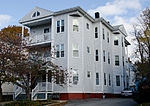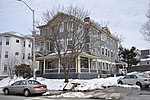St. Mark's Episcopal Church (Worcester, Massachusetts)
19th-century Episcopal church buildingsChurches completed in 1888Churches in Worcester, MassachusettsChurches on the National Register of Historic Places in MassachusettsEpiscopal church buildings in Massachusetts ... and 3 more
National Register of Historic Places in Worcester, MassachusettsRomanesque Revival church buildings in MassachusettsStone churches in Massachusetts

St. Mark's Episcopal Church is an historic Episcopal church building at Zero Freeland Street in Worcester, Massachusetts. The Romanesque Revival stone building was designed by local architect Stephen C. Earle, and built in 1888 for a congregation established the preceding year. On March 5, 1980, the church building was added to the National Register of Historic Places as St. Marks. The current priest is the Rev. Robert Carroll Walters.
Excerpt from the Wikipedia article St. Mark's Episcopal Church (Worcester, Massachusetts) (License: CC BY-SA 3.0, Authors, Images).St. Mark's Episcopal Church (Worcester, Massachusetts)
Lowell Court, Worcester
Geographical coordinates (GPS) Address Nearby Places Show on map
Geographical coordinates (GPS)
| Latitude | Longitude |
|---|---|
| N 42.247777777778 ° | E -71.826111111111 ° |
Address
McDonald's
Lowell Court
01610 Worcester
Massachusetts, United States
Open on Google Maps











